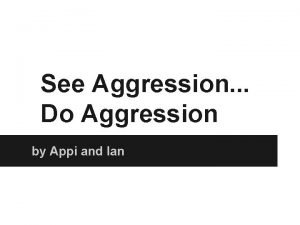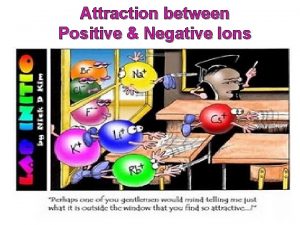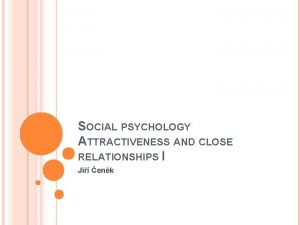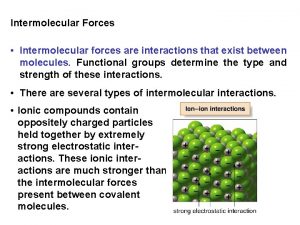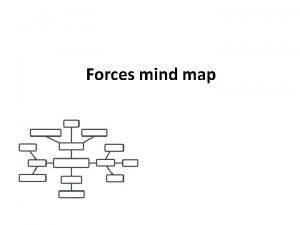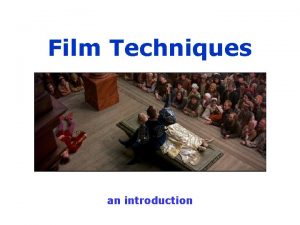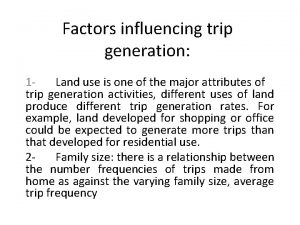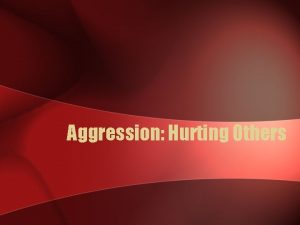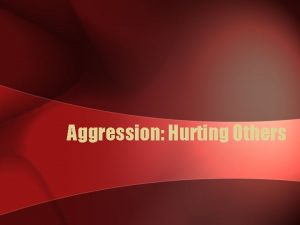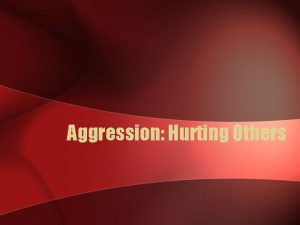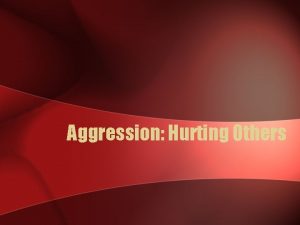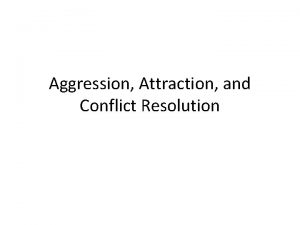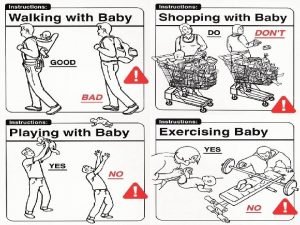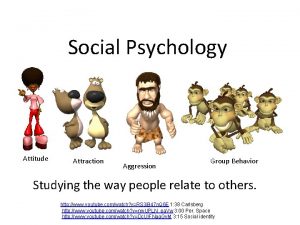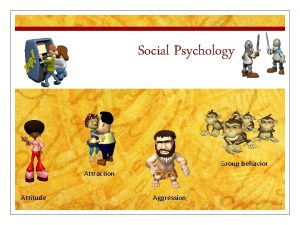Chapter 18 Aggression and Attraction Aggression any physical































- Slides: 31

Chapter 18 Aggression and Attraction

• Aggression – any physical or verbal behavior intended to hurt or destroy

Aggression • Causes of Aggression – What do you think is the cause of aggression? – Is it instinctual? – What are physical and psychological influences on aggression? – Do we learn aggression, and if so, how? – What effect does mass media violence have on aggression? – How can we use our knowledge of aggression to solve contemporary world problems?

Aggression Group Presentation • Using the text book and using at least 3 reliable internet sources, create a PPT within your group to teach your section to the class. You must be able to explain what you are teaching! • Your PPT should have at least the same number of slides as members in your group. Each member should participate in the presentation. • Be sure to highlight vocabulary words and give examples when available • Be sure to include school appropriate visuals • Create 3 thoughtful questions to ask your classmates to stimulate discussion • Each group will have 10 minutes to present their section. You should use all your time! Help your classmates (and yourself) out and participate in discussion!

Groups 1. Biology of Aggression (749 -750) 2. Averse Events and frustration-aggression principle; Learning Aggression is rewarding (751752) 3. Observing models of aggression (media and aggression) and acquiring scripts (752 -753) 4. Video Games (including “close-up”) section (754756) 5. Conflict and Social Traps and Enemy perceptions (756 -758) 6. Altruism, Bystander Intervention, and Norms for Helping (764 -766) 7. Peacemaking (767 -769)

Grading Rubric • Quality of Content 15 14 13 12 11 10 9 7 5 3 1 Carefully described all necessary components and used examples not in the book to explain concepts, used at least 3 online sources • Quality of Presentation 10 9 8 7 6 5 4 3 2 1 Students all spoke (not just one speaker), students spoke audibly, enthusiastically, did not read directly from the powerpoint, took time for classmates to write. • Team work 5 4 3 2 1 Every student participated during computer time& in the presentation • Power Point 10 9 8 7 6 5 4 3 2 1 Power. Point was neat and organized, the content was clearly, concisely written, spelling was correct, visuals were included, appropriate number of slides for the group • Discussion 10 9 8 7 6 5 4 3 2 1 Group create 2 -3 thoughtful discussion questions that related the topic to contemporary issues or generated analysis of the topic; students in group participated in other group generated discussions • Total Grade out of 50 and you’ll have to provide your online Sources Citations

Instinct Theory • Aggression is an innate tendency, something toward which people are biologically predisposed. – Sigmund Freud maintained that people periodically need to discharge a natural aggressive energy, thus saying that human aggression may be a normal and perhaps unavoidable fact of life.

Frustration-Aggression Principle • Principle that frustration – the blocking of an attempt to achieve some goal – creates anger, which can generate aggression

Social Learning Theory of Aggression • Other theories of aggression maintain that aggressive behavior is purely the product of social learning. – People are aggressive because they have learned how to be aggressive, perhaps by watching other people act in such a fashion

Bandura Clip

Aggression • Conflict – perceived incompatibility of actions, goals, or ideas • Social Trap – a situation in which the conflicting parties, by each rationally pursuing their self-interest, become caught in mutually destructive behavior • Conservation of natural resources

The Pairing Game • Do not look at your number or tell anyone their’s • Task: Pair off with another student. • The way to pair off is to ask “will you be my partner” and the person can accept or reject your offer with a “yes or no” • If accepted, stand together off to side of room • If rejected, continue looking until you have formed a pair

• How did you arrive at the pairing? • How does this apply to everyday life? • Do we all carry around a sense of our own value (self-esteem)? How might this perception develop through social interaction?

The Psychology of Attraction picture

Interpersonal Attraction • Social attraction to another person – Physical Proximity: Physical nearness to another person in terms of housing, school, work, and so on – Mere Exposure Effect: We are attracted to people we see the most frequently – We are attracted to people who are similar to us – Physical Attractiveness: Person’s degree of physical beauty as defined by his or her culture

Fig. 18. 4 What do people look for when considering potential dating partners? Here are the results of a study in which personal ads were placed in newspapers. As you can see, men were more influenced by looks, and women by success (Goode, 1996). • Pretend you are an evolutionary psychologist – why do you think women are more concerned with success?

Halo Effect • We have Cognitive bias in that we tend to generalize a favorable impression to unrelated personal characteristics – Good looking people tend to be more successful Success

Attractiveness is Relative • Beauty is in the eye of the culture – In Cameroon and many other parts of Africa, obesity has been associated with abundance, desirability, and fertility. – In a rite of passage, some Nigerian girls spend months gaining weight in what is known as “the fattening room”.

• Padaung women Southeast Asia in • Custom of placing rings around their necks from when they are young girls until they marry. • The pressure and weight of the rings (as much as 11 pounds) force the chin upward while pressing down the collar bones and ribs, elongating the neck.

• Lip plates have been around in some African tribes for thousands of years. • Young girls stretch their lips with round wooden or clay plates and wear them throughout their lives.

Every period of history held its own standards on what was and was not considered beautiful.

What are things the American culture considers beautiful? • How does the media influence our definition of beauty? • Is the American idea of beauty healthy?

Love • What does love mean to you? picture

Different Kinds of Love…. • Companionate Love – deep affectionate attachment we feel for those with whom our lives are intertwined

• Passionate Love – an aroused state of intense positive absorption in another – usually present at the beginning of a love relationship (puppy love)

Essentials for an Enduring Relationship • Equity – Both partners give the same amount • Self-Disclosure – Process of revealing private thoughts, attitudes, feelings and one’s history to others – Overdisclosure: Self-disclosure that exceeds what is appropriate for a relationship or social situation

Do Opposites Attract? • No! We like people who are similar to us physically and in interest • The strongest relationships are with those who share things in common

Altruism • Unselfish regard for the welfare of others – What are some acts of altruism you’ve seen or done?

Diffusion of responsibility • is a social phenomenon which can occur in groups of people above a certain critical size when responsibility is not explicitly assigned • Diffusion of responsibility can manifest itself: – in a group of people who, through action or inaction, allow events to occur which they would never allow if they were alone. (groupthink, the bystander effect) – in a group of people working on a task that loses motivation because people feel less responsible and hide their lack of effort in the group (social loafing).

Kitty Genovese • Bystander Effect: Any particular bystander is less likely to give aid with other bystanders present

1 Notice an event? Yes 2 No Interpret as an emergency? Yes 3 No Assume responsibility for helping? No Yes 4 Know how to help? No Yes 5 Decide to help implement intervention? Yes Help victim No Do not help
 See aggression do aggression
See aggression do aggression See aggression do aggression
See aggression do aggression There aren't any bananas
There aren't any bananas Any to any connectivity
Any to any connectivity Any question atau any questions
Any question atau any questions Chapter 27 anger aggression and violence
Chapter 27 anger aggression and violence Stages of assault cycle
Stages of assault cycle Polar attraction chapter 8
Polar attraction chapter 8 Polar attraction chapter 8
Polar attraction chapter 8 A physical property is any characteristic of
A physical property is any characteristic of What is the attraction between positive and negative ions
What is the attraction between positive and negative ions Physical attractiveness
Physical attractiveness Theories of attraction
Theories of attraction Interpersonal attraction theories
Interpersonal attraction theories The pricing tripod
The pricing tripod Physical activity and physical fitness assessments grade 9
Physical activity and physical fitness assessments grade 9 Van der waals forces
Van der waals forces Explain newton’s universal law of attraction/gravitation.
Explain newton’s universal law of attraction/gravitation. Kinetic theory of solids
Kinetic theory of solids Reward theory of attraction examples
Reward theory of attraction examples Cohesive and adhesive
Cohesive and adhesive Field of repulsion
Field of repulsion Detection of local attraction
Detection of local attraction Personal attraction meaning
Personal attraction meaning Intermolecular forces
Intermolecular forces Van der waals attraction
Van der waals attraction Strongest to weakest intermolecular forces
Strongest to weakest intermolecular forces Love relationship and friendship goes everywhere
Love relationship and friendship goes everywhere Concept map intermolecular forces
Concept map intermolecular forces The westermarck effect
The westermarck effect Deep attraction l drama
Deep attraction l drama Factors influencing trip generation
Factors influencing trip generation
